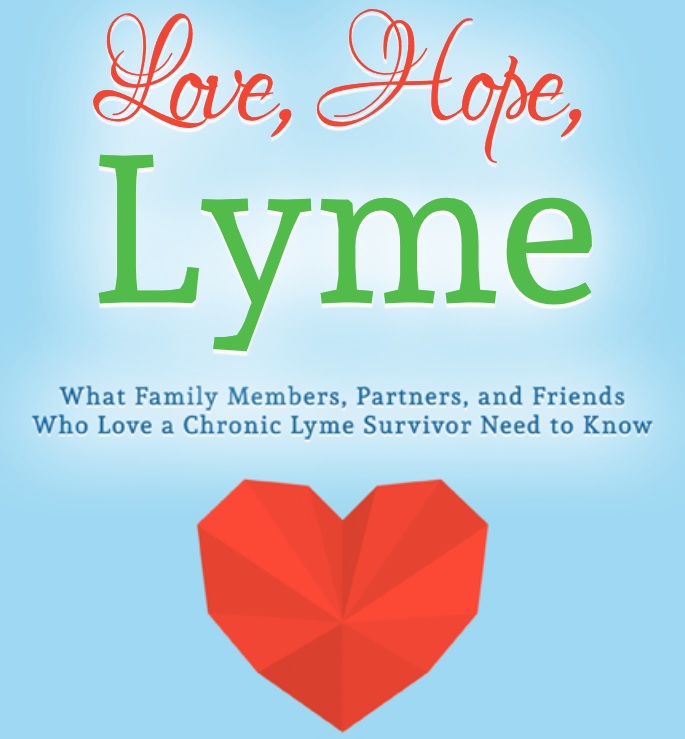Does your partner have Lyme disease? This book’s for you.

When Fred Diamond fell in love with a woman who had Lyme disease, he didn’t have a clue about what she was going through.
Even after they’d been together 11 years, he came to realize that he STILL didn’t really understand the challenges she faced.
So, he decided to change that.
He bought a lot of books about Lyme disease and started reading. And reading. And reading.
He joined Lyme disease Facebook groups. And he sought out people in the Lyme community with his many questions.
Along the way, he wrote about what he learned in a number of blogs on the LymeDisease.org website.
Learning to be supportive when your partner has Lyme disease
My top 12 recommended books on Lyme disease
Career and life lessons from survivors of chronic Lyme disease
How TJ Nelson excels at sales while battling chronic Lyme disease
Earning a living with chronic Lyme: “I’m not going to make it out of bed today.”
Love, Hope, Lyme
Now, he’s compiled what he has learned from this research into a book called Love, Hope, Lyme: What Family Members, Partners, and Friends Who Love a Chronic Lyme Survivor Need to Know.
He says he wrote the book for people who are like what he once was—a partner who knew nothing about how to offer true support to a loved one battling Lyme disease.
“I wanted to write something that someone could digest in 60-90 minutes to begin to understand what this person was going through.”
He includes such topics as an overview of Lyme disease, detoxification, neurological concerns, and the politics of Lyme. He also incorporates interviews with Lyme survivors talking about what helped them the most.
The following is an excerpt of the book, where Diamond provides an introduction to gluten-free eating—a challenge faced many Lyme patients.
“Being gluten-free before it was cool”
Questions to ponder:
• Why is a gluten-free diet important to Lyme survivors?
• Should you modify your diet to support your partner?
• How important is proper nutrition for Lyme treatment?
• Why is your partner concerned about a leaky gut?
Nutrition plays a crucial role in the Lyme survivor’s life. Adapting to a new eating lifestyle and knowing what to eat is perhaps the most crucial component of healing this disease.
Supporting your loved one in dietary changes will be an adjustment. Hopefully, you can be flexible, patient, and take time together to create a list of foods to eat and not to eat.
I discovered that many Lyme survivors are gluten-free. Many have been gluten-free before gluten-free was the cool thing. Many Lyme-literate medical doctors (LLMDs) prescribe a gluten-free diet for Lyme survivors because gluten promotes inflammation in the body.
A person can be allergic to gluten and/or have a sensitivity to it. If allergic, they cannot have any cross-contamination of gluten. It is crucial to read labels on products and make sure they were made in a facility dedicated to gluten-free products.
Also, many people with Lyme cannot eat out at restaurants. There are too many cross-contaminants in restaurant food and in the kitchens. Even though a restaurant may say the food is gluten-free, you cannot be certain without dedicated spaces.
No one knew what gluten-free meant when we first started dating. We had to educate our friends and family on what gluten-free entailed. When we visited anyone, they supported getting gluten-free food to make it easier.
Going out to eat can be challenging. However, as gluten-free becomes more widely accepted, menu choices have expanded. Still, you may find that the only options are a piece of chicken or a hamburger without a bun and some veggies. If you want dessert after the meal, most likely the only option is a scoop of ice cream.
One thing that I got good at was finding the best gluten-free pizza wherever we went. Thank goodness for Yelp. We probably tried every brown rice flour, amaranth flour, buckwheat flour, chickpea flour, almond flour, cornmeal flour, millet flour, navy bean flour, quinoa flour, and cauliflower pizza crust known to humankind.
We explored every place that sold gluten-free pizza in the tri-state area. I did not mind shifting to gluten-free pizza, although there were times when I missed good old traditional pizza; however, my figure didn’t.
Of course, due to the gluten allergy, your partner or family member might also need to refrain from drinking beer or brown liquors.
Alcohol is an inflammatory food and should be avoided. Alcohol can contribute to chronic inflammation. In fact, chronic inflammation is often linked to alcohol-related health conditions.
When your body metabolizes alcohol in your gastrointestinal (GI) tract, it can disrupt tissue homeostasis. This can cause a chronic state of inflammation in the intestines. Alcohol can also cause inflammation in the joints.
AnnaMarie Houlis states in her article “Alcohol and Inflammation” that “Because alcohol can cause inflammation, it can also be the root cause of joint and muscle pain. Alcohol intake can bring on or trigger existing joint and muscle pain.” (Houlis 2022).
According to the Natural Paleo Family website, “Lyme can directly affect the liver, overburdening it with filtering out toxins excreted by the pathogens in your body. The result is that the excess toxins put it into a weakened state. Once in this weakened state, drinking alcohol can make it worse. The bottom line is that the body sees alcohol as poison, and when you drink it, the liver prioritizes the processing of the alcohol, and everything else gets put on hold in the meantime.” (Natural Paleo Family 2020)
Blood sugar can get low when you have Lyme disease and coinfections. On one of our first dates, my partner and I drove near Atlantic City, heading to a local diner for dinner. My partner’s blood sugar was running low. Luckily, I had some nut bars in the trunk.
According to Thomas Ball, when dealing with Lyme disease, what you eat is essential to your health. In addition to gluten, other foods to consider eliminating due to their inflammatory properties are sugar, dairy, legumes, soy, red meats, and more. (Ball 2020)
I read several articles that said to eat foods that provide a more alkaline environment than acidic. Supposedly Lyme bacteria cannot survive in a more alkaline environment.
What is a leaky gut?
Finally, there is the whole leaky gut problem. Certain foods can cause the lining of the small intestine to weaken. As a result, small holes can develop that allow food particles and bad bacteria to escape the intestine into the bloodstream.
If this happens, your immune system goes into attack mode, thus causing more inflammation. Having a healthy small intestine is essential to absorb your vitamins and minerals.
Dairy and sugar may also need to be removed or at least limited from the diet. These products tend to have yeast, which promotes the growth of the bacteria. Animal’s milk contains casein, a protein that can cause inflammation in the infected victims, according to drprem.com. (Global Health Care, n.d.)
Eliminating sugar is a priority. All these dietary components play a significant role in treating Lyme disease. In a previous chapter, I introduced you to J. P. Davitt. He recommends an elimination diet to remove toxic ingredients from your daily intake.
Specific foods to eliminate include:
- Corn syrup, which is addictive and causes the pancreas to use a massive amount of insulin. Pancreas health and insulin production is directly correlated to aging.
- Hydrogenated oils such as canola oil, which is another name for rapeseed oil. These oils are literally burnt, and the process that creates them builds toxicity in the body that destroys your hormones. In addition, these oils have a screwed-up molecular structure. They are found in margarine, fried foods, coffee creamers, potato chips, and packaged snacks.
- Gluten, which is in many foods because we cut corners and shortcut the manufacturing of our food. It causes holes in the intestines and leaks, causing autoimmune symptoms. (Davitt 2021)
Maintaining the best diet can be confusing. We will make mistakes, so making more good choices than bad sounds like our best option.
Although everyone has a different makeup, some anti-inflammatory foods that might help with recovery include:
- Avocado
- Coconut oil
- Fruits
- Leafy greens
- Nuts
Reprinted with permission from Love, Hope, Lyme: what Family Members, Partners, and Friends Who Love a Chronic Lyme Survivor Need to Know, by Fred Diamond (2022).
Click here for information about purchasing this book.
TOUCHED BY LYME is written by Dorothy Kupcha Leland, Board President of LymeDisease.org. She is co-author of When Your Child Has Lyme Disease: A Parent’s Survival Guide. Contact her at dleland@lymedisease.org.





















We invite you to comment on our Facebook page.
Visit LymeDisease.org Facebook Page